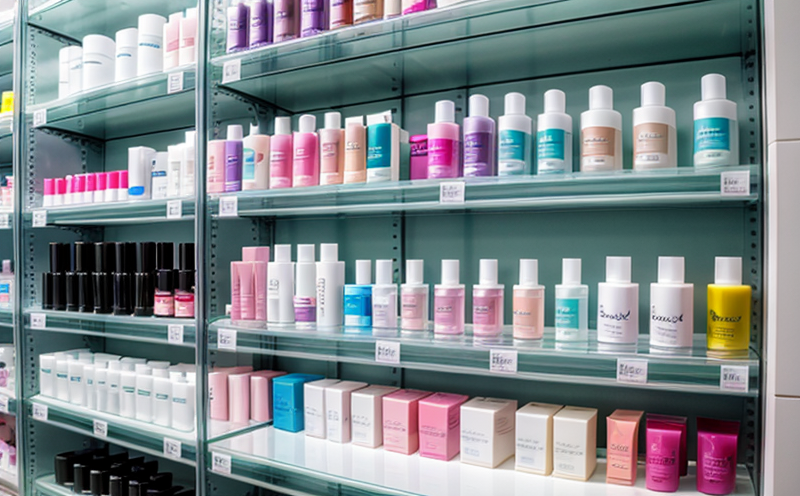Light Exposure Stability Testing in Cosmetic Formulations
The stability and shelf life of cosmetic formulations are critical factors that influence consumer satisfaction and product performance. Light exposure stability testing is a key aspect of ensuring the efficacy, safety, and longevity of your cosmetic products. This test evaluates how well a formulation maintains its quality under conditions similar to real-world use.
Light can cause significant degradation in cosmetic products by initiating photochemical reactions that alter color, texture, and potency. Understanding light exposure stability is crucial for formulators to develop products that remain effective over time. This testing ensures compliance with regulatory standards such as ISO, ASTM, and local cosmetic regulations.
During this test, samples are exposed to light sources that simulate various real-world conditions. The most common types of light used include fluorescent lamps, xenon arc lamps, and UV lamps. Each type mimics different environmental factors such as sunlight or artificial lighting. By exposing the sample to these lights for specific durations and wavelengths, testers can determine how much degradation occurs over time.
The testing process involves several steps:
- Sample Preparation: The cosmetic formulation is prepared in a manner that reflects real-world packaging conditions (e.g., clear bottles or jars).
- Light Exposure: Samples are placed under controlled light sources for predetermined periods.
- Data Collection: Various physical and chemical properties of the sample are measured before and after exposure.
- Analysis: Changes in appearance, consistency, pH levels, stability, and other relevant factors are analyzed to assess degradation rates.
The results from these tests provide valuable insights into potential issues with light-induced instability. This information helps developers refine their formulations to enhance shelf life without compromising safety or efficacy. Properly conducted stability testing ensures that the final product meets both regulatory requirements and consumer expectations.
Understanding light exposure stability is particularly important for companies operating in diverse markets where varying environmental conditions may affect product performance. By investing in robust stability testing, manufacturers can ensure consistent quality across all regions while also meeting specific local standards.
Why Choose This Test
- Promotes Product Safety: Ensures that the cosmetic formulation remains stable and safe for extended periods without adverse effects on users.
- Achieves Regulatory Compliance: Meets international standards like ISO, ASTM, and local regulations to ensure market entry across different jurisdictions.
- Enhances Consumer Trust: Builds confidence among consumers by demonstrating commitment to product quality and safety.
- Improves Product Performance: Identifies potential degradation issues early in the development process allowing for necessary adjustments before mass production starts.
- Saves Time & Costs: By identifying problematic formulations early, companies avoid costly recalls or rejections after launch.
- Supports Innovation: Encourages continuous improvement and innovation by providing actionable data on how to enhance product stability.
- Ensures Longevity: Helps extend the shelf life of cosmetic products making them more sustainable in terms of both environmental impact and consumer satisfaction.
Quality and Reliability Assurance
The importance of quality control cannot be overstated when it comes to cosmetics. Stability testing plays a pivotal role in ensuring that the formulations meet strict criteria for safety, efficacy, and durability. By incorporating light exposure stability tests into their product development cycle, manufacturers can significantly improve the reliability of their final products.
Quality assurance in cosmetic formulation involves multiple stages including raw material selection, formula design, manufacturing processes, packaging materials, storage conditions, and distribution channels. Each stage requires careful consideration to maintain high standards throughout production. Stability testing serves as a crucial checkpoint within this process by evaluating how well the product withstands exposure to light over time.
Through rigorous stability testing, companies can identify any potential weaknesses early on in the development phase before proceeding further into production stages. This proactive approach not only saves resources but also enhances overall quality assurance practices. It ensures that once a formulation passes all relevant tests, including light exposure stability trials, it will perform reliably throughout its shelf life.
In addition to enhancing product reliability, thorough quality control measures contribute positively towards brand reputation and customer satisfaction. Consumers are increasingly aware of the importance of safe and effective cosmetics which makes reliable performance even more essential for maintaining consumer trust. By investing in robust stability testing procedures, brands demonstrate their commitment to delivering high-quality products that meet both regulatory requirements and market expectations.
Customer Impact and Satisfaction
The impact of light exposure stability on customer satisfaction cannot be underestimated. When customers purchase a cosmetic product expecting it to last for an extended period without losing its efficacy or quality, they rely heavily on the manufacturer's ability to provide such assurances. For many consumers, the perceived value of a product depends significantly on how long it remains effective after opening.
Light exposure stability testing ensures that once customers open their purchased cosmetic products, these items retain their intended qualities longer than if left unprotected against environmental factors like sunlight or artificial lights. This extended shelf life translates directly into higher customer satisfaction because they can continue using the product without fear of degradation due to light-induced reactions.
Moreover, reliable stability testing supports brand loyalty by fostering trust between consumers and brands. Customers are more likely to remain loyal if they consistently receive products that meet their expectations regarding quality and longevity. Brands that invest in robust stability testing programs build a strong reputation for reliability which contributes positively towards long-term customer relationships.
In summary, light exposure stability testing plays an integral role not only in enhancing product performance but also significantly impacting customer satisfaction by ensuring consistent effectiveness throughout the shelf life of cosmetic products. This aligns perfectly with broader business goals related to brand reputation and customer retention.





